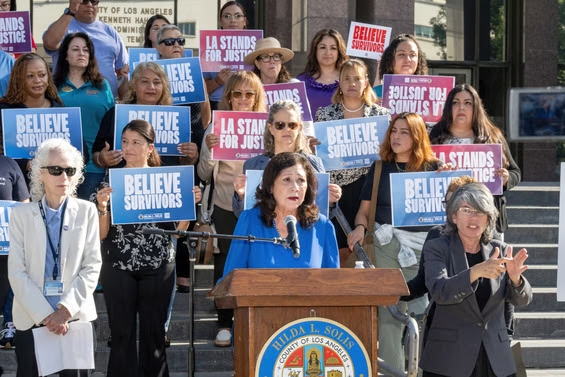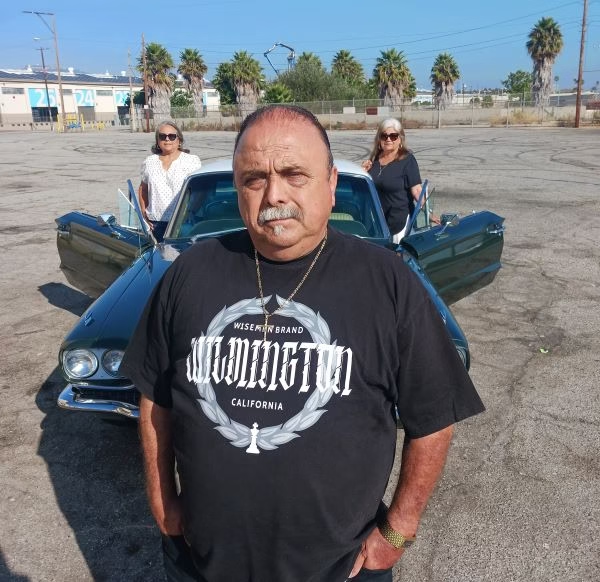“To see what I saw. Nobody should ever have to see that of your loved one,” Ronnie Fematt said, recalling his words during the victim’s impact court hearing in 2019. “She was five months pregnant. I was taking care of her child. I was looking forward to my job, and I already gave [the unborn child] a name, Sophia, after my mother and my grandmother. That’s when I lost it in court.” Fematt said he stayed up all night writing all he wanted to say to the man convicted of killing his wife 45 years ago.
“I wrote about five pages of what I was going to tell this son of a bitch,” Fematt said. “I was going to tell it. Get it all off my chest now that we know the killer. When I get up to the podium, the judge goes, ‘You know, how this works, right? You’re to address the court, not him.”
The Murder of Teresa Broudreaux
For fans of police procedures and documentaries of unsolved cases, LA Harbor residents have had a real treat on their Netflix account and not even realized it. For more than a year, the documentary series “Homicide: Los Angeles,” which focuses on detectives and prosecutors as they revisit their most challenging homicide cases in Los Angeles, has been streaming.
Three episodes in, the series revisits the killing of Wilmington resident Teresa Broudeaux, whose nude body, except for some knee socks, was found among the rocks at Malaga Cove beach.
Twenty-year-old Broudreaux was a mom to a four-year-old daughter, a newlywed, and five months pregnant at the time of her death.
Investigators said she died from a blow to the head with a heavy object, and her body appeared as if it had been dumped on the beach.
The case went unsolved for more than 35 years, until witnesses came forward and advances in technology resulted in a DNA match.
In the initial reports at the time of the murder, investigators were quoted as saying there was evidence that Broudreaux knew her killer and that they were not able to talk to Ronnie Fematt, her husband of five months, because he hired a lawyer (his uncle Henry Salcido), who told him to keep his mouth shut.
For nearly four decades, her husband, Ronnie Fematt, endured suspicious stares, rumors from neighbors, and gossiping co-workers who thought he was responsible for the death of his wife.
“I felt like a suspect,” said Fematt, who was 23 at the time. “I wasn’t the one.”
In 2017, LA County sheriff’s detectives announced the arrest of Robert Yniguez, 65, a registered sex offender outside his San Pedro home in Broudreaux’s killing. Detectives believe Yniguez did not know Broudreaux.
Ronnie Femmatt boasted of 19 years of sobriety when he stopped by Random Lengths News a few weeks ago. He joked that food was his only addiction these days. But that sobriety came after a hard-fought, 30-year battle with addiction — a battle he would not have been able to fight if not for the sage advice of an attorney uncle when his wife’s body was recovered from Malaga Cove.
Fematt reflected on the aftermath of his wife’s murder, describing how her family suspected and even threatened him in the years following Broudreaux’s death, with little progress in finding the killer. The 68-year-old grandfather believes his first wife’s stubbornness and her independent and strong-willed spirit ultimately led to her tragic death.
“I lost my wife and my kid that night. The DNA [of the fetus] was mine. … She thought nothing could happen to her. That’s the tragedy of it.”
He described the ongoing torment after her murder — living under suspicion, battling substance use, and reliving the details of her death through nightmares.
Fematt believes grief, suspicion, and public judgment fueled his drug use through his second marriage, which collapsed when his wife left him. He says he used drugs to numb the pressure, but always knew he had potential, recounting taking unseriously addiction recovery programs as part of his parole conditions only to go back to his addiction habits that got him there in the first place.
He just believed he was built differently. What would have killed others, he survived. It took a health crisis and his guilt over burdening his family with his addiction to get him to quit.
Fematt said he has always been a high-functioning addict, able to take care of his basic needs, maintain a job, and a household while still getting high. This particular attribute meant he was able to be sober long enough to become a longshore worker
“I had to go to so many meetings when I was always in trouble with the law. Most of the time, I’d just cheat and lie and sign myself. But then I realized the answer is in my head, I have the answer, all I have to do is say no. And no meeting can teach you that. You have to know in your gut, ‘I’m done.’ When I decided, I quit everything … the drinking, the drugging, and the smoking … everything. The one will lead to the other. If I start smoking, I’ll want a beer. If I start smoking drugs and drinking beer, I’ll want cigarettes again. It’s a vicious cycle, so I just said I’ll stop everything,” Fematt said.
His decision to live was strengthened by a desire for justice for his wife and unborn child and to prove wrong those who doubted he’d survive past the age of 40.
His wife, Christina, with whom he has been in a relationship for more than 20 years before they married a year ago, stood by him despite rumors and skepticism, helping him build a life of trust, honesty, and stability. Nearly 20 years sober, retired longshore worker, and happily married, he exudes gratitude. And he credits Christina with teaching him how to truly live after years of addiction and loss. One of the byproducts of that change was restoring a classic 1966 Thunderbird.
Fematt reflects on his father’s tough love approach after Broudreaux’s murder.
During the ‘80s, many families were wrecked by drug addiction; it was a crisis that afflicted families across the board.
Fematt said he believed his mom used to be a little mean to him because he was so much like his father. The elder Fematt was a baseball player for many years and would drink every day after the game. Then her sons became alcoholics and addicts.
“I could see why she was a little upset,” Fematt said.
However, all the things that he would need to take care of himself, particularly when he was single, such as cooking, washing, and ironing his own clothes, he credits her with.
“Money was different back then, but they’re barely making it work, but we got a good education,” Fematt explained. and learned the religious part of life [as a Catholic]. Communion, confirmation, and baptism we learned. Kids had to spend their weekends going to catechism because they don’t teach that at school.
He talks about raising his surviving son, Ronnie Fematt Jr., insisting he never abandoned him even as he battled addiction. Fematt takes pride in the fact that his relationship with his son is particularly strong now. He honors values passed down from his father—loyalty, discipline, and sacrifice—even as he witnesses generational changes in parenting and his father’s decline after losing his wife.
Fematt’s life began to change when he began to do longshoring work. But making decent money and supporting his family wasn’t enough to give Fematt peace. Even there, rumors about his alleged involvement in his wife’s murder spread among colleagues whom he accuses of being jealous of him. He recalls hostile police treatment and false accusations, including being arrested for a stabbing he didn’t commit. With the help of his uncle Henry, the charges didn’t stick.
It took Fematt having his own near-death experience following kidney failure 20 years ago to turn to a life of sobriety. He’d lost enough and didn’t want to lose anything else. Getting justice for Teresa was important, but for Ronnie Fematt, the real work was on himself.













